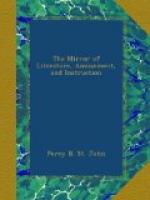“There are a variety of dances to which the term National may, with some propriety, be applied. Among the most celebrated of these are,—the Italian Tarantula, the German Waltz, and the Spanish Bolero. To dwell on their peculiarities would, however, as it appears to us, be useless: the first is rarely exhibited, even on the stage: the second, although it still retains much of its original character, has, in this country, been modified into the Waltz Country Dance, and all the objections which it encountered, on its first introduction, seem to have been gradually overcome, since it assumed its present popular form; and the graceful Bolero is restricted to the theatre only, being never introduced to the English ball-room.
“The manner of walking well is an object which all young ladies should be anxious to acquire; but, unfortunately, it is a point too much neglected. In the drawing-room, the ball-room, or during the promenade, an elegant deportment, a ’poetry of motion,’—is, and ever will be, appreciated. The step ought not to exceed the length of the foot; the leg should be put forward, without stiffness, in about the fourth position; but without any effort to turn the foot out, as it will tend to throw the body awry, and give the person an appearance of being a professional dancer. The head should be kept up and the chest open: the body will then attain an advantageous position, and that steadiness so much required in good walking. The arms should fall in their natural position, and all their movements and oppositions to the feet be easy and unconstrained. The employment of soldiers to teach young ladies how to walk, which, we are sorry to say, is a practice adopted by many parents and heads of seminaries, is much to be deprecated. The stiffness acquired under regimental tuition, is adverse to all the principles of grace, and annihilates that buoyant lightness which is so conducive to ease and elegance in the young.”
Besides the host of cuts incorporated with the text, each art has a whole page embellishment exquisitely engraved on wood; the designs of which are the very acme of taste. The head and tail, and letter pieces of the chapters are in equally good taste; and taken altogether, the “Young Lady’s Book,” either as a production of usefulness or illustratration of art, is the finest production of its day. It has been erroneously noticed, from its publication at this season, as an “Annual,” but it displays infinitely more pains-taking than either of those elaborate productions—and is, we should judge, neither the labour of one or two years.




